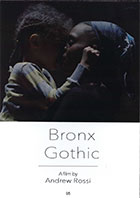
Bronx Gothic 2017
Distributed by Grasshopper Films, 12 East 32nd St., 4th Floor, New York, NY 10016
Produced by Andrew Rossi, Okwui Okpokwasili
Directed by Andrew Rossi
DVD , color, 91 min.
General Adult
Performing Arts, Dance, Theater, Performance Art, African Americans, Adolescence
Date Entered: 03/12/2018
Reviewed by Timothy Hackman, University of MarylandOkwui Okpokwasili’s one-woman dance and performance piece, Bronx Gothic, begins even before the audience has taken their seats. As the audience enters, the artist stands facing the corner of a sparsely decorated stage, her angular shadow thrown from a bedroom lamp placed on the floor. She writhes and twitches in a dance that is intimate and yet isolated, personal and painful to watch. Her frenetic, arrhythmic dancing lasts a full thirty minutes, while the audience settles in and grows increasingly discomfited. “Is this part of the show?” the viewer can see them thinking. “Will this last much longer?” “Is the show going to start soon?” What the artist is doing, she explains, is challenging the audience to watch and be present, to leave their own lives and concerns outside the confines of the theater and to engage with the living, breathing performer in front of them.
The film, Bronx Gothic, follows the creator and performer of the piece by the same name, as she combines dance, song, and acting to tell the story of two twelve-year-old girls growing up black in the Bronx of the 1980s. Okpokwasili says the piece is not autobiographical, but it is based in her own experience as a black woman in America, and is about “the pleasure and pain of a brown girl.” The film weaves long segments of performance with behind-the-scenes footage of Okpokwasili speaking with students from Alverno College and the Bronx Academy of Arts and Dance in “artist talkback” sessions, as well as in workshops and rehearsals preparing the piece. Through these conversations the viewer gets a good sense of Okpokwasili’s creative process and the motivations behind her art.
The film also follows the artist as she interacts with her family, including her husband, Peter Born (who helped design the piece), daughter, and parents. The segment with her parents is particularly engaging and moving. Middle class Nigerian immigrants, her parents are supportive of, yet somewhat perplexed by, the nature of her work. As they watch the thirty-minute introductory dance to Bronx Gothic on a laptop, her mother is primarily concerned about the strenuous physical activity, while her father observes that she is “trying to make some statements” and that her work “takes a lot of creativity.” But then her mother makes the connection between her daughter’s dancing and the traditional dances of Nigeria. She begins to demonstrate the steps in the living room, while the artist’s own daughter frolics on the floor, joyfully imitating her grandmother. It is a delightful, intimate moment in which three generations of black women are brought together by art and dance.
Overall, the value of the film is the exposure to Okpokwasili’s work, which had only a limited run in a small theater. Also valuable is the insight of the artist herself, as she makes connections between Bronx Gothic, violence against people of color, and images of that violence in the media. “My brown body is a political site,” she observes. The film could also potentially be useful for programs with adolescent girls. One of the artist’s stated goals is for girls and young women to be able to know and talk about their bodies; silencing their voices, she says, leaves them vulnerable to exploitation and abuse. The excerpts of the performance piece contain profanity and frank sexual language, so educators should use caution and consider local standards if using the program with high school audiences. This film is recommended for college and university libraries, particularly those with strong programs in performing arts or African American studies.